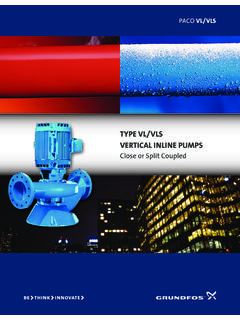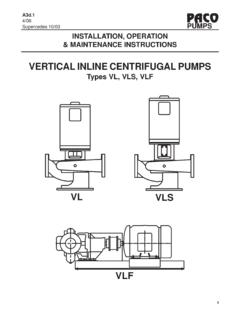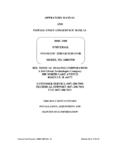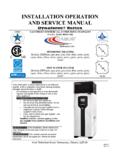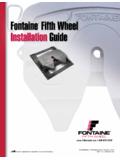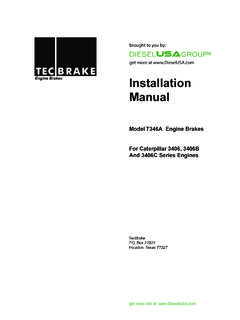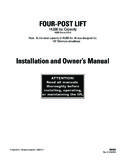Transcription of INSTALLATION, OPERATING & MAINTENANCE …
1 9/05 PPPPPACOACOACOACOACO PUMPSINSTALLATION, OPERATING & MAINTENANCE INSTRUCTIONSType L End Suction 9/05 PPPPPACOACOACOACOACO PUMPSTABLE OF MECHANICALA. Pump 3B. 3C. Temporary 3D. 3E. Horizontal Pump 3F. Securing The Base 4G. Vertical Pump 4H. Piping-General .. (Inlet) 4-5J. Discharge (Outlet) 5K. Shaft Sealing-General 5L. Packing Gland Adjustments .. 5M. Mechanical 5-6N. Coupling Motors, 6-7B. installation 7B. Pre-Start 7-8C. Motor Rotation .. 7D. Starting The 8E. Voltage 8F. Pump 8G. Short Duration 8H. Extended Period 8-9IV. MAINTENANCEA. Motor 9B. Pump 9C. Disassembly of Pumps .. 10D. Reassembly of 10V. ORDERING 11-12VI.
2 TROUBLE SHOOTINGA. Symptoms .. 12 AND SERVICE 15 CAUTIONS and WARNINGS are inserted at key points of this manual to provide check points for personneland machinery safety. CAUTIONS: Apply to personnel. WARNINGS: Apply to personnel and 9/05 PPPPPACOACOACOACOACO these instructions thoroughly before installingand OPERATING your PACO Type L Centrifugal operation depends on careful attention tothe procedures described in Sections I, II, III and IV ofthis manual. Keep this instruction manual handy forfuture PUMP IDENTIFICATION All PACO Pumps are identified by Catalog andSerial Numbers. These numbers are stamped onthe pump nameplate ( a) affixed to each pumpvolute casing, and should be referred to in allcorrespondence with the Company.
3 PACOPACOPACOPACOPACO PUMPSB. RECEIVING Check pumping unit for shortage and damageimmediately upon arrival. Pump accessories whenrequired are packaged in a separate container andshipped with the unit. If equipment is damaged in transit, promptly reportthis to the carrier s agent. Make complete notationson the freight bill to speed satisfactory adjustmentby the carrier. Unload and handle the unit with a sling. Do not liftunit by eye bolts on the motor!C. TEMPORARY STORAGE If pump is not to be installed and operated soon afterarrival, store it in a clean, dry area ofmoderate ambient temperature. Rotate the shaft by hand periodically to coat bearingwith lubricant to retard oxidation and 1a Follow motor manufacturer s storage recommenda-tions where LOCATION Locate the pump as close to the suction supply aspossible.
4 Use the shortest and most direct suctionpiping practical. Refer to paragraph H. SUCTION(INLET) PIPING. Locate the pump below system level whereverpossible. This will facilitate priming, assure asteady liquid flow, and provide a positive suctionhead. Make sure sufficient NPSH (Net Positive SuctionHead) is provided at the suction end by consideringthe pump s location in relation to the entire NPSH must always equal or exceedrequired NPSH specified on the pump performancecurve. Always allow sufficient accessibility for maintenanceand inspection. Provide a clear space with amplehead room for use of a hoist strong enough to liftthe unit. Make sure a suitable power source is available forthe pump motor. Electrical characteristics shouldmatch those specified on the motor data plate,within the limits covered in Sections II and III.
5 Avoid pump exposure to sub-zero temperatures toprevent pump liquid from freezing. If freezing condi-tions exist during shutdown periods, see SectionsIIIE and IIIF for specific HORIZONTAL PUMP FOUNDATION Horizontal pumps should be permanently installedon a firm, concrete foundation mounting pad ofsufficient size to dampen any vibration and preventany deflection or misalignment. The pad may floaton springs or be a raised part of the equipmentroom floor. The foundation should be pouredwithout interruption to 3/4 to 1-1/2 inches belowthe final pump elevation. The top surface shouldbe well scored or grooved before the concrete setsto provide a suitable bonding surface for the bolts should be set in pipe sleeves forpositioning allowance, as shown in (Fig.)
6 2a) onpage 4. Allow enough bolt length for grout, lowerbase plate flange, nuts and washers. Allow thefoundation to cure several days before proceedingwith pump #:10-20707-130101-1741 STOCK #:SER #: #####97R12345 BROOKSHIRE, TEXAS34014412 : 9/05 PPPPPACOACOACOACOACO PUMPSFIGURE 2a: Anchor Bolt InstallationF. SECURING THE BASE PLATE After the concrete pad has been poured and set,lower the pump base plate over the anchor bolts andrest it on loose adjustment wedges or shims placednear each anchor bolt and at intervals not to exceed24 along each or wedges must be placed to raise thebottom of the base 3/4 to 1-1/4 above the pad,allowing clearance for grout. Level the pump shaft,flanges, and base plate using a spirit level, adjustingthe wedges or shims, as required.
7 Check to make sure that the piping can be alignedto the pump flanges without placing any strain oneither flange. After pump alignment has been established, putnuts on foundation bolts and tighten them justenough to keep the unit base plate from a form or dam around the concrete padand pour grout in and around the pump base, asshown in (Fig. 2a). Grout compensates for unevenfoundation, distributes the weight of the unit, andprevents shifting. Use an approved, nonshrinkinggrout (such as Embeco 636 by Master Builders,Cleveland, Ohio or equivalent). Allow at least 24hours for this grout to set before proceeding withpiping connections. After the grout has thoroughly hardened, check thefoundation bolts and tighten if necessary. Recheckthe pump alignment after the foundation bolts VERTICAL MOUNTING INSTRUCTIONSThe PACO LCV Vertical Close Coupled pump need notbe grouted to its foundation, but should be anchoredwith 4 anchor bolts set in concrete similar to thehorizontal anchoring arrangement (Fig.)
8 2a).FIGURE 3aH. PIPING-GENERAL Do not use pump as a support for piping! Usepipe hangers or other supports at proper intervals toprovide complete piping support near the pump. Both suction and discharge piping should beindependently supported and properly aligned sothat no strain is transmitted to the pump when flangebolts are tightened. Make sure piping is as straight as possible, avoidingunnecessary bends and fittings. Where necessary,use 45 or long-sweep 90 pipe fittings to decreasefriction loss. Where flanged joints are used, make sure thatinside diameters properly match and mounting holesare aligned. Do not spring or force piping when making anyconnections! (INLET) PIPINGThe sizing and installation of suction piping is particu-larly important.
9 It must be selected and installed in amanner that minimizes pressure loss and permitssufficient liquid flow into the pump during starting andoperation. Many NPSH problems can be traced directlyto improper design of suction piping systems. Observethe following precautions when installing suction piping: Suction piping should be as direct as possible, andideally the length should be at least ten times thepipe diameter. Short suction piping can be the samediameter as the suction opening. Longer pipingshould be one or two sizes larger (depending onlength), reducing to the diameter of the pumpsuction TO ALLOWANCE FORGROUTDAMPIPE SLEEVEWASHERWEDGES OR SHIMSLEFT IN OF FOUNDATION: LEAVEROUGH, CLEAN, & WET 9/05 PPPPPACOACOACOACOACO PUMPS occurs, pressure gauges will indicate wide fluctua-tion in suction and discharge DISCHARGE (OUTLET) PIPING Short discharge piping can be the same diameter asthe pump discharge opening.
10 Longer piping shouldbe one or two sizes larger depending on length. An even gradient is best for long horizontal runs ofdischarge piping. Install a valve near the discharge opening to primeand start the pump. The discharge gate valve is alsoused to isolate the pump during shutdown, mainte-nance, and facilitate pump removal. Any high points in discharge piping may entrap air orgas and thus retard pump operation. If the possibility of liquid hammer exists, ( checkvalves are used) close the discharge gate valvebefore pump SHAFT SEALING-GENERAL COMMENTS PACO offers both mechanical seals and packedstuffing boxes as a means to seal the shaft. Pumpswith stuffing boxes are normally packed before ship-ment. If the pump is installed within 60 days aftershipment, the packing material will be in good condi-tion for operation with a sufficient supply of lubrica-tion.


